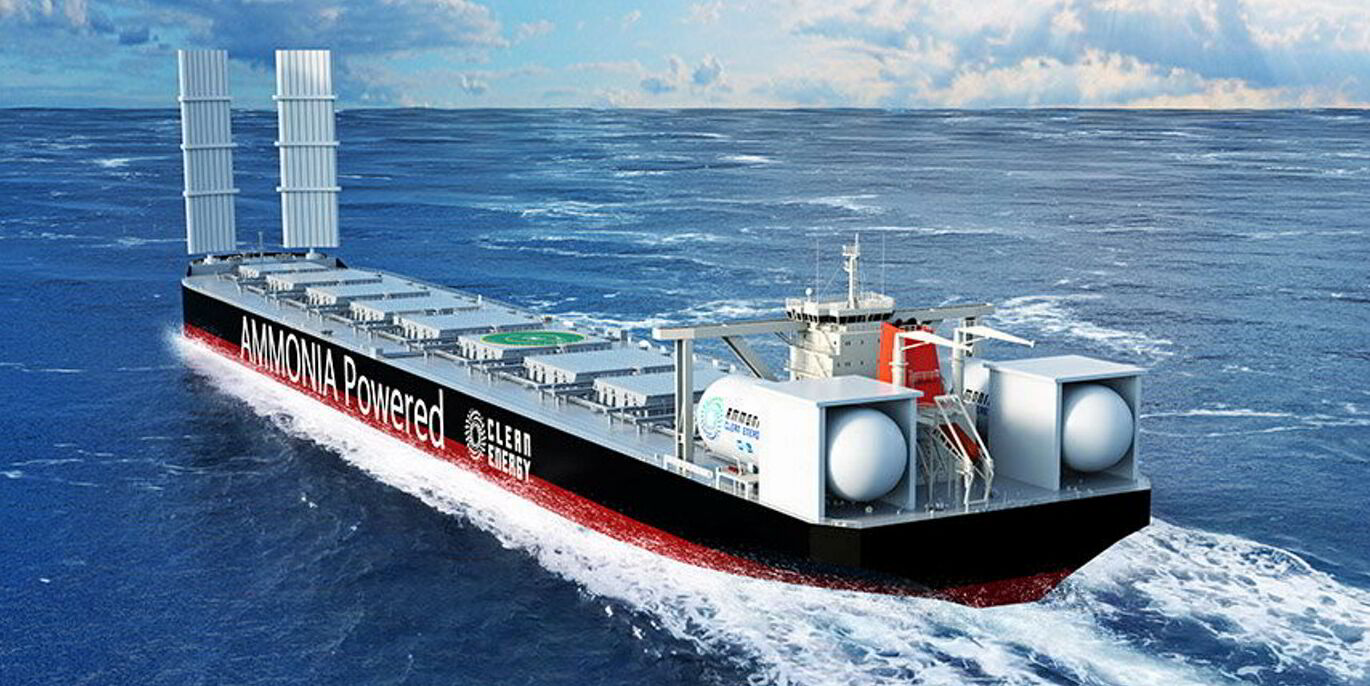A new study has raised questions on whether ammonia as a marine fuel is as “green” as its promoters make it out to be.
Ammonia has been ranked high as the next green shipping fuel alternative with several shipbuilders planning for the transition, but a study at the Massachusetts Institute of Technology has found that burning it could worsen air quality instead of improving it.
Ammonia is made by stripping hydrogen from natural gas and then combining it with nitrogen at extremely high temperatures, a process resulting in a large carbon footprint.
Green ammonia, on the other hand, is produced using renewable energy to make hydrogen from water via electrolysis. It is a development many are relying on as a more environmentally friendly option, and, theoretically, it is.
Burning green ammonia in a ship’s engine produces no carbon emissions.
However, the study found that even the greenest ammonia will generate nitrous oxide (N2O) and nitrogen oxides (NOx) when combusted, and may cause unburnt ammonia to slip out into the atmosphere.
N2O, which MIT researchers claim is 300 times more potent than CO2, will remain in the atmosphere as a greenhouse gas for more than a hundred years.
When the escaped NOx and ammonia mix with gases in the air, they form fine particulate matter, a primary contributor to air pollution. When inhaled deep into the lungs, these tiny particles can cause health problems such as asthma, heart attacks and strokes.
Anthony Wong, lead author of the study and a postdoctoral associate at MIT’s Center for Global Change Science, said: “Saying that ammonia is a ‘clean’ fuel is a bit of an overstretch. Just because it is carbon-free doesn’t necessarily mean it is clean and good for public health.”
An all-rounded approach
Due to the absence of real-world data from any ammonia-powered ships, the study’s research relied on experimental ammonia combustion data.
To gather the most accurate environmental and public health impacts of using ammonia fuel, MIT designed various scenarios to measure how ammonia affects climate change under specific technology and policy assumptions.
Two different ship engines were considered, the first burning pure ammonia and the second involving mixing ammonia with hydrogen. The first engine generated higher levels of unburnt ammonia but less NOx while the second improved combustion and optimised the performance of a catalytic converter, which controls NOx and unburnt ammonia pollution.
Three policy scenarios were considered — the current regulations that only limit NOx emissions in some parts of the world, one that adds ammonia emission limits over North America and Western Europe, and one that adds global limits on ammonia and NOx emissions.
A ship track model was used to calculate pollutant emissions under each scenario. The results were then fed into an air quality model to calculate the impact of ship emissions on particulate matter and ozone pollution and to estimate the impact on global public health.
Study findings
The study highlighted the potential environmental benefits of reducing NOx and greenhouse gas emissions when switching to ammonia-powered ships.
It discovered that under current regulations, switching the entire fleet to engines burning pure ammonia would cause 681,000 additional premature deaths each year.

By using cleaner engine technology, the number of premature deaths is cut by about 20,000, and together with stronger global regulations, the number of casualties is reduced by about 66,000.
“While a scenario with no new regulations is not very realistic, it serves as a good warning of how dangerous ammonia emissions could be. And unlike NOx, ammonia emissions from shipping are currently unregulated,” Wong said.
When evaluating the overall environmental impacts of the transition to ammonia, the results also showed the importance of considering local air quality impact and the complete lifecycle emissions of ammonia production.
Noelle Selin, co-author and MIT professor, said: “There is a potential for ammonia in shipping to be beneficial for both climate and air quality, but that requires that regulations be designed to address the entire range of potential impacts.
“Not all climate solutions are created equal. There is almost always some price to pay. We have to take a more holistic approach and consider all the costs and benefits of different climate solutions, rather than just their potential to decarbonise,” Wong said.
Researchers hope to refine their analysis when more data is available.
They also urged the industry to share engine data that can be used to evaluate air quality and climate impacts.
The study also aims to inform policymakers about the importance and urgency of updating shipping emission regulations.
Shipping accounts for almost 3% of global CO2 emissions and causes an estimated 100,000 premature deaths each year.
By 2030, the International Maritime Organization strives to reduce greenhouse gas emissions from international shipping by at least 40%, with the global fleet switching from fossil fuels to sustainable fuels.
Industry response
TradeWinds asked classification society DNV and the Singapore-based Global Centre for Maritime Decarbonisation (GCMD) for their views on the MIT report.
Tore Longva, director of decarbonisation at DNV Maritime, said the classification society “welcomes any research on the application of new technologies and fuels to ensure that they are safe and sustainable to use”.
“Although the lack of data presents a challenge, the first ammonia-fuelled ship — the Green Pioneer — is now in operation and more ships are expected to be delivered next year. This will provide the opportunity to learn more about the emissions and safety aspects associated with ammonia as fuel, and how any adverse effects can be mitigated and also addressed in policy-making,” he said.

Professor Lynn Loo, CEO of the GCMD, agreed with the study’s conclusion and its call for policies to govern the use of ammonia fuel in shipping.
“As we ready ourselves for a transition to new fuels that promise significantly lower carbon emissions, we must not lose sight of the potential unintended consequences these new fuels may bring,” she said.
“Robust regulations will need to be in place to ensure operational safety and minimise negative environmental and health impacts.”
Loo also highlighted the need to use real data from ship trials to strengthen future analyses.
She noted that GCMD’s efforts have taken into account real-world operational conditions, which have helped to provide more detailed and specific information, enhancing the study or analysis being conducted.
Some of the organisation’s efforts regarding the use of the fuel include completing a safety study on piloting ammonia bunkering with location and configuration specifics, which have allowed for qualitative risk assessment.
The GCMD is also “preparing to conduct pilots to transfer ammonia at conditions as close to bunkering operations as possible at key ports”.
“These learnings can help operationalise crew training, and develop safe handling procedures and emergency response plans to mitigate ammonia release,” Loo said.
“To the point of the MIT study, GCMD’s pilots can also help inform policy recommendations to mitigate the unintended release of ammonia and harmful pollutants that result from its use as a marine fuel.”






